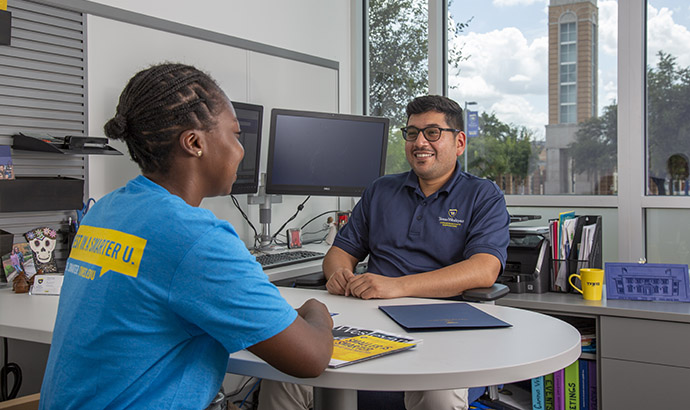Courses Taught
- ASE-1111 (Freshmen Success Experience)
- CHE-1403 (Nature of Physical Sciences)
- CHE-1405 (Forensic Science I)
- CHE-1415 (General Chemistry I)
- CHE-1416 (General Chemistry II)
- CHE-3101 (Seminar in Chemistry)
- CHE-3418 (Analytical Chemistry)
- CHE-4412 (Advanced Instrumental Analysis)
- CRJ-4494 (Internship)
Publications
Peer Reviewed Journal Articles
- Donnan, P.H., Ngo, P.D., and Mansoorabadi, S.O., Constant pH Accelerated Molecular Dynamics Investigation of the pH Regulation Mechanism of Dinoflagellate Luciferase. Biochemistry, 2018. 57(3): p. 295–299
- Ngo, P.D. and Mansoorabadi, S.O., Evidence for a Biologically Unprecedented Twisted Intramolecular Charge Transfer Mechanism of Dinoflagellate Bioluminescence. ChemPhotoChem, 2017. 1(9): p. 383-387.
- Zheng, K., Ngo, P.D., Owens, V.L., Yang, X., and Mansoorabadi, S.O., The biosynthetic pathway of coenzyme F430 in methanogenic and methanotrophic archaea. Science, 2016. 354(6310): p. 339-342.
- Ngo, P.D., S.O. Mansoorabadi, and P.A. Frey, Serine Protease Catalysis: A Computational Study of Tetrahedral Intermediates and Inhibitory Adducts. J Phys Chem B, 2016. 120(30): p. 7353-9.
Book Chapters
- Mansoorabadi, S. O., Zheng, K., and Ngo, P. D., F430 Biosynthesis and Insertion. Encyclopedia of Inorganic and Bioinorganic Chemistry, 2017 p: 1–12.
Presentations
- Quantitative distance determination: A novel method for determining shooting distance using liquid chromatograph mass spectrometry, Spring 2025 American Chemical Society National Meeting, San Diego, CA, March 2025.
-
Development of a Novel Method for the Quantification of 11ß-hydroxysteroid dehydrogenase expression in blood for the diagnosis of hypercortisolism, Spring 2025 American Chemical Society National Meeting, San Diego, CA, March 2025.
-
Computational investigation of antibacterial drug candidates based on a 1,2, 4 oxadiazole linker, Spring 2025 American Chemical Society National Meeting, San Diego, CA, March 2025.
- Enzymatic investigation of the inhibitory effect of a 2,4 diaminopyrimidine on Escherichia coli dihydrofolate reductase, Spring 2025 American Chemical Society National Meeting, San Diego, CA, March 2025.
- Enzymatic investigation of the inhibitory effect of a 2,4 diaminopyrimidine on Escherichia coli dihydrofolate reductase, Spring 2024 American Chemical Society National Meeting, New Orleans, LA, March 2024.
- Quantitative distance determination: A novel method for determining shooting distance using ultraviolet/visible spectroscopy, Spring 2024 American Chemical Society National Meeting, New Orleans, LA, March 2024.
- Uncertainty of Measurement and the TriggerScan™, 2018 Annual Alabama State Association of Forensic Sciences Conference, Miramar Beach, FL, June 2018.
- A Decade of Gun Crime in Alabama, 2018 Annual Alabama State Association of Forensic Sciences Conference, Miramar Beach, FL, June 2018.
- Firearm and Tool Mark Unit: Advancing Forensic Firearms Analysis, Alabama State University Annual Research Symposium, Montgomery, AL, March 2018
- Firearm and Tool Mark Unit Research and Development Section, Alabama State University Department of Forensic Sciences Seminar, Montgomery, AL, October 2017.
- Firearms and Tool Marks Research and Development, 2017 Annual Alabama State Association of Forensic Sciences Conference, Miramar Beach, FL, June 2017.
- Advancing Forensic Firearms Analysis with Confocal Microscopy, Alabama Department of Forensic Sciences Directors Meeting, Auburn, AL, November 2016.
- Identification and characterization of a novel chlorophyll catabolite from the bioluminescent dinoflagellate Pyrocystis fusiformis, 67th Southeast/71st Southwest Joint Regional Meeting of the American Chemical Society, Memphis, TN, November 2015.
- The mechanism of dinoflagellate bioluminescence: A computational approach to elucidating the structure of the luminophore of dinoflagellate luciferase, 67th Southeast/71st Southwest Joint Regional Meeting of the American Chemical Society, Memphis, TN, November 2015.
- Dinoflagellate bioluminescence: Elucidation of the biosynthetic pathway of luciferin in Pyrocystis fusiformis, 65th Southeast Regional Meeting of the American Chemical Society, Atlanta, GA, November 2013.
- Illuminating the Sea and Science, Auburn University College of Science and Mathematics Interdisciplinary Colloquium, Auburn, AL, February 2013.
- Dinoflagellate bioluminescence: The Cloning, Heterologous Expression, and Purification of the Luciferin-Luciferase Bioluminescence System of Pyrocystis fusiformis, Southwest Regional Meeting of the American Chemical Society, Austin, TX November, 2011.
- Dinoflagellate bioluminescence: cloning and sequence analysis of luciferase from Pyrocystis fusiformis, Rice University Research Symposium, Houston, TX, October 2011.
- Dinoflagellate bioluminescence: Cloning of luciferase genes and purification of luciferase-containing organelles of Pyrocystis fusiformis, Texas Academy of Sciences Meeting, Austin, TX, March 2011.
- Dinoflagellate Bioluminescence: Cloning of luciferase genes and purification of luciferin containing organelles from Pyrocystis fusiformis, Sam Houston State University Research Symposium, Huntsville, TX, April 2010.
- Cloning of Pyrocystis fusiformis genes for the purposes of plasmid insertion and heterologous expression in Escherichia coli, Texas Academy of Sciences Meeting, Stephenville, TX, March 2010.








